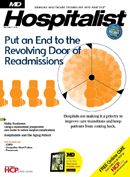Publication
Article
MDNG Hospital Medicine
Building a Better Program: Out with the Old, In with the New
Author(s):
Now is the perfect time to determine whether your hospitalist program measures up, and it if doesn’t, to find the problems and fix them
By Ken Simone, DO
How many hospitalist practices operate at 100% efficiency and have no room for improvement? I would venture to say not many, if any. Does your program regularly evaluate performance? The new year is an optimal time to implement novel initiatives that will improve practice performance.
A hospitalist practice may fall short in one of a number of crucial areas involving nonclinical or clinical operations. Underperformance may occur within practice operations, such as the billing department, which can directly impact the bottom line. Practice operations may be suboptimal regarding recruitment, retention, or marketing. Provider performance may be subpar when it comes to both medical record documentation and coding. Clinical performance may lag in other areas, such as outcomes, resource utilization, efficiency, and/or teamwork. Hospitalist programs should focus on one or two areas of underperformance— unless a total overhaul is necessary.
The overarching goal for any hospitalist program is to deliver quality medical care (eg, clinical outcomes) while maintaining fiscal responsibility. Notice, I didn’t say “while finishing in the black.” That’s because most hospitalist programs require subsidy to provide a full spectrum of services. It is the hospitalist provider’s responsibility to deliver quality medical care, but that alone is not “mission accomplished.” He or she must do so in an efficient and cost-effective manner. The hospitalist medical director is responsible for ensuring that this occurs with each provider and with the practice as a whole. Furthermore, it is the practice manager’s responsibility to make certain the program optimally performs from both an operational and financial perspective. Both the medical director and hospitalist practice manager should work closely with hospital administration to align their goals and vision. This will allow the hospitalist program to provide services that assist the medical community and patient base.
What problem(s) has your program experienced this past year? What area(s) would you like to improve? Perhaps census is down on your hospitalist service. If this is true, a review of customer satisfaction may be in order to assess whether there’s an internal problem. Have you assessed whether the problem resides within the hospital (ie, with services offered and/or hospital department performance)? If satisfaction is high and there are no indications that patients are going elsewhere, plans should be created to expand your referral network. This can be accomplished by creating new alliances with primary care physicians and specialists within the community. Consideration should also be given to aligning the hospitalist program with providers and healthcare networks outside of the immediate catchment area. These tactics will support census growth within your practice.
Your hospitalist practice should also reevaluate the scope of service it offers. If the practice has underperformed financially, would expanding or contracting services provide a solution? Careful analysis of the program’s scheduling model, staffing, utilization, and provider efficiency can offer valuable information. The hospitalist leaders can develop a new strategic plan from this data to improve the bottom line.
The New Year is an excellent time to implement necessary staffing changes. If during the evaluation process data show that your providers are unproductive and/or inefficient, the medical director and practice manager should assess whether the program is understaffed. If morale is low, this may be another indication that the program is understaffed. In this event, the following questions should be asked: Why are we understaffed? Is it because of our success and utilization of our program is growing? Is it a result of poor recruitment and/or lack of retention? What is our practice culture?
If your providers are not productive and the program is appropriately staffed, then now is the time to determine the root cause for the inefficiencies. Are provider expectations clearly defined? Does the hospitalist medical director lead by example? Does the scheduling model support productivity? Are the hospitalists properly incentivized to perform at a high level?
Ken Simone, DO, FHM, is a board-certified family physician and the founder and president of Hospitalist and Practice Solutions, a consulting company that develops, restructures, and redesigns hospitalist programs.
Have a question for Ken Simone about building and maintaining a hospitalist program? E-mail tkunkler@mdng.com.






